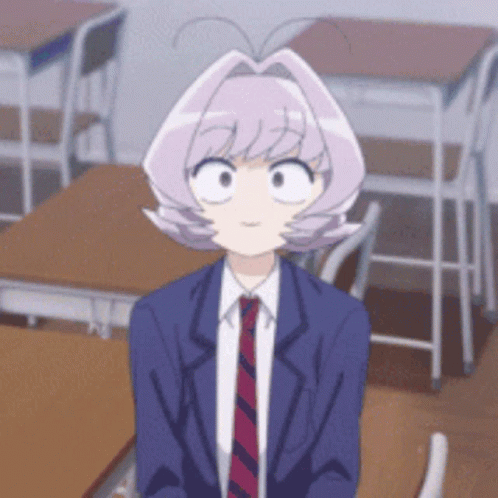
I might have a new favorite anime, one that I will happily watch with my teens when the time comes in the fall for the anime and manga club to restart! It kept me company during the brain fog of covid these last almost 2 weeks, and that’s saying something.
If you’re looking for a show to fill the Ouran High School Host Club hole in your heart, look no further than Netflix’s adaption of Komi Can’t Communicate. It skirts by with a PG rating, though some humor/tropes are decidedly – pointedly – PG-13+, but on the whole this show is a wholesome slice of life with an organic slow burn almost-romance that dodges fan service opportunities left and right while still feeling authentic to teens and anime lovers.
I have yet to read the manga, but knowing it’s on my shelves at work (and came recommended by another teen librarian) I feel even more comfortable offering it as a suggestion to teens looking for Horimiya read-alikes, as well as the aforementioned Ouran High School Host Club.
Shoko Komi has social anxiety, and as the show carefully points out in almost every episode, Komi has trouble forming connections with people — but that doesn’t mean she never wants to forge them. In fact, her goal once befriended by the amiably average Tadano, is to make 100 friends.

Slice of life hijinks ensue with an ensemble cast of characters that are given main character treatment in their overall design, as well as some LGBT representation with the over the top character of Naijimi (and technically Yamai, but we’ll get in to her later). With a plot that relies on the absurd extremes of mistunderstandings you might only get in the stylized culture presented in anime/manga (not specifically real world Japan), buckle up for a wholesome adventure.
While Komi’s beauty and the dehumanization she experiences because of it are played up, Tadano’s average-ness makes him an every day hero. Everyone else in the show, with little exception, is quite unique — it is the show’s willingness to play into those character flaws and/or idiosyncrasies that allows for the absurd to flavor in what otherwise feels like a humble slice-of-life. The ensemble is actually what propels the show rather than relying solely on Komi and Tadano’s relationship. It is also the ensemble that pushes the envelope on that “PG” rating it was assigned by Netflix.
In terms of appropriateness, while there isn’t any overt fan service there is explicit reference to kink (shibari, and an extended pet play bit applied to a character), explicit jokes about arousal, and implication of anime fan service tropes. I don’t necessarily think those are taken to the degree I’d deem the show unwatchable by a younger audience, but watchers of a certain age might have some questions if the jokes aren’t flying over their heads. Given what, unfortunately, they’re exposed to already, portraying kids joking about these topics and testing their waters is not too outside the pale of reality in my opinion and this show could be a good litmus test for opening those conversations if kids have questions. (And there are plenty of online resources for having those conversations as well, including my annotated sex ed for teens path finder).

There isn’t a clear villain in the show either, just the ways characters get in their own way, something I think a lot of viewers can relate to. The closest we might come to an antagonist is Yamai, a girl with a borderline obsessive crush on Komi. The animators have a lot of fun with expressions in this anime, and Yamai in particular gets drawn with styles evoking other genres not limited to survival/horror. She is one of the clearer subversions of traditional anime tropes of the lecherous love interest. It isn’t inherently good or bad, just the sort of reminder about how other shows write and animate their characters.
The animation style in particular doesn’t feel too cutting edge, but isn’t to be ignored either. Having a protagonist that hardly, if ever, speaks means getting creative with emoting as well as relying heavily on ironic pop-up informatics that show the depth of miscommunication at times.
As someone who prefers subbed to dubbed anime, I also need to give a special shout out to the translator for these episodes, as well as the formatter for them given the show relies a lot more on text needing to be translated and not just dialog. If you also enjoy subtitles, there is a slight learning curve to the order stuff is happening on the bottom of the screen, but it is accomplished with such precision that I didn’t find myself tripping up between watching and reading.
Ultimately, if you were on the fence about watching or reading (which I will be sure to do a follow-up on) Komi Can’t Communicate, I highly recommend setting aside an hour or so to watch the first few episodes, but if I’m being really honest — clear your evening because you’ll want to binge all 20+ episodes as they’re told in a chronological “mission” format that’s short and sweet, with sometimes 2-3 missions in an episode. It hits that sweet spot for slice of life fans, as well as those who love subversion and cliches.